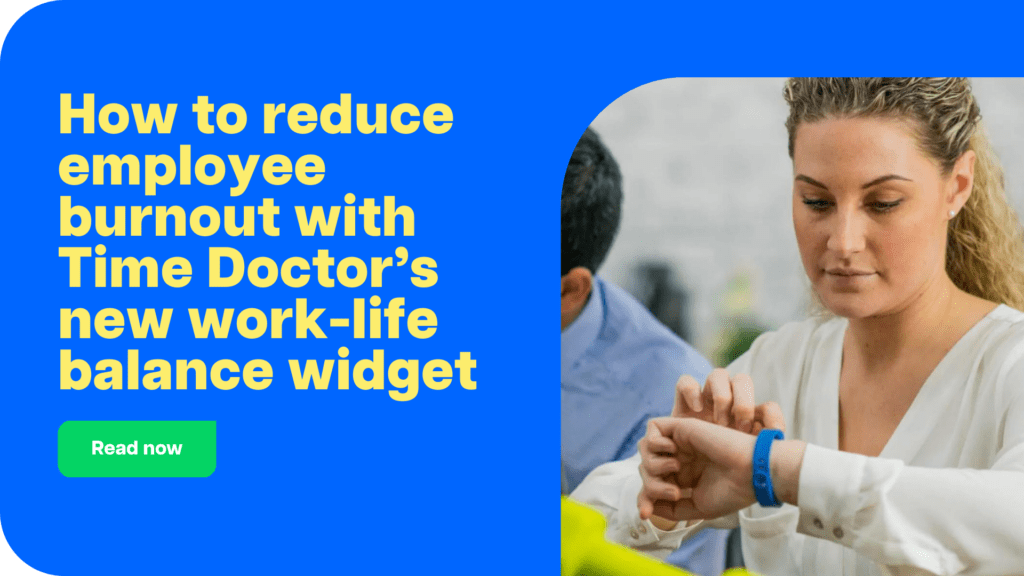The Covid 19 pandemic has put a spotlight on mental health.
However, the fear of stigma deters employees from discussing their mental health problems at work. That’s why it’s all the more important for employers to promote mental health in the workplace.
Promoting good mental health in the company can help create a holistic environment that increases everyone’s productivity and keeps them engaged in their work.
In this article, we’ll discuss the importance of addressing workplace mental health. We’ll also talk about three early signs of poor mental health and cover five effective ways to promote mental wellbeing at work.
This article contains
(Click the links below to directly go to a section of your choice)
- 3 Reasons for Addressing Mental Health in the Workplace
- What are the Early Signs of Poor Mental Health?
- 5 Ways to Promote Positive Mental Health in the Workplace
Let’s get started.

3 reasons for addressing mental health in the workplace
The World Health Organization describes mental health as a state of wellbeing in which an individual:
- Realizes their own abilities.
- Can cope with the normal stresses of life.
- Can work productively.
- Is able to contribute to their community.
Here’s why good mental health is critical to any workplace:
1. Helps in the growth and development of your employees
Mental health issues can prevent employees from taking up new projects or meeting deadlines.
Such performance may give their managers the impression that they’re not fully engaged and committed to their work. However, this may not always be the case.
Employees with work related stress, depression, and anxiety can experience a dip in performance despite their best efforts.
That’s why it’s important to address an employee’s mental health when assessing their performance and to give them suitable growth opportunities.
2. Boosts productivity
Focus is a key to an employee’s productivity.
But any mental health concern such as anxiety or depression can stop employees from giving their best.
On the other hand, an employee with access to adequate mental health care services can work without any major concerns for their wellbeing. Such employees can perform their tasks better, are more engaged, and commit to long-term goals more confidently.
3. Reduces employee turnover rates
Gen-Z and Millennial candidates dominate today’s job pool.
However, about 75% of Gen-Z and 50% of Millennial employees have left their jobs owing to mental illness and related concerns.
Against the backdrop of growing awareness about mental health, this statistic calls for companies to relook their traditional outlook. Organizations can no longer put down mental health issues to an employee’s personal life choices.
Recognizing the workplace triggers for such conditions can help you provide better mental health services.
Young people seek a friendly work environment that empowers them. That’s why an open conversation about mental health at the workplace helps a company attract the best talent and keep turnover rates down.
What are the early signs of poor mental health?
Often, people who suffer from mental health troubles are not confident talking about it because of the stigma around it. Or they might not be aware that they are suffering from a mental health disorder.
Without adequate care or someone to talk to, their mental health may worsen over time.
The bottom line is that knowing early signs of mental ill health can help you assist them with good mental health care from an early stage.
Here are some common examples of a mental disorder and their symptoms:
- Depression: Lack of engagement or interest in day-to-day activities, loss of appetite and energy, increased irritability, etc.
- Generalized anxiety disorder: Loss of focus, worrying, fatigue, being physically tensed, etc.
- Panic disorder: Heavy breathing or panting, etc.
- Obsessive-Compulsive Disorder (OCD): Feeling the need to repeat some actions.
- Post-Traumatic Stress Disorder (PTSD): Shaking and shivering, anxiety, etc.
Let’s now explore the important early signs of poor mental health in detail:
1. Physical signs
Many people associate poor mental health with emotional and behavioral issues, which is partially true.
However, studies show that it can cause physical pain as well.
Most physical symptoms may seem ordinary but may indicate underlying mental health issues if they recur or hamper a person’s routine.
Some of these include:
- Headaches.
- Feeling fatigued throughout the day.
- Back pain.
- Abdomen pain.
Early identification of these symptoms can help you identify and correct the cause quickly.
2. Psychological signs
Some psychological signs that can help you figure out whether your employees need help are:
- Confusion and distraction: Disorganized speech, losing their train of thought, etc.,
- Memory lapse: Trauma and emotional distress can lead to severe memory lapses and retention issues.
- Tearfulness: A tearful employee can have potential mental health issues related to work stress and pressure.
These signs may be hard to pick up at first glance. However, people who work closely with each other can tell when their co-worker is having a hard time fulfilling their basic responsibilities.
In such cases, they must be encouraged to offer attention and support to people who’re struggling with such symptoms at work.
3. Behavioral signs
You should look out for the following behavioral signs that may indicate mental health conditions:
- Aggression: Increased irritability and aggression in an employee’s behavior can signify stress and a worsening mental health condition.
- Risky decision-making: Due to an altered mental state such as mood swings that may arise from bipolar disorder.
- Increased absence: Longer break times and more day-offs due to fatigue or other physical symptoms.
- Increased substance use: Growing dependence on alcohol, nicotine, or contraband substances, especially during work hours.
Co-workers and employers may unknowingly interpret such behavior as a sign of a bad attitude and penalize the employee. However, this can only worsen their psychological health.
If an employee displays such behavioral symptoms, it’s best to encourage them to seek behavioral health treatment.
5 simple ways to promote positive mental health in the workplace

Here are five ways to deal with mental health challenges in a workplace environment and improve employee wellbeing.
1. Create company policies on mental health
A well-thought-out and fair employee mental health policy will help you prepare for the common mental health challenges. It also clearly communicates your stand on mental issues to new hires.
Some policies that you can include in your company are:
A. Anti-discriminatory policy
Workplace discrimination on the basis of mental health conditions can create a hostile work environment and prevent people from seeking help.
Anti-discriminatory policies take a clear stand on how other employees should treat people suffering from mental health issues at work. With such a policy in place, the affected employees can seek redressals for any workplace discrimination.
These workplace wellness policies will ensure that employees get a safe work environment where they can work freely.
B. Leave policy
Most employees may fear that taking time off for mental illness can have repercussions on their job. However, this fear multiplies their problems and continues to affect their performance at work.
Companies should recognize that mentally stressed people may harm themselves by working with their condition and also negatively affect their environment.
In addition to the usual leaves, you can include stress leaves and mental health days to ensure the employees prioritize their mental well being.
Companies can also create an Employee Assistance Program (EAP) that offers mental health benefits. It can help many employees solve their personal problems like addiction, substance abuse, etc.
2. Increase mental health awareness in the workplace
You need to start by addressing the stigma around mental health issues in the workplace. You can do this by organizing workshops, seminars, and mental health programs.
Mental health professionals can teach employees how to approach and communicate with people suffering from a mental health issue.
The human resource department can also conduct helpful activities such as intervention sessions on mental health day, which is on the 10th of October every year.
These mental health interventions can significantly strengthen trust between employees.
However, awareness shouldn’t be limited just to the workplace. Employees can apply these lessons to help their family members and friends and uplift their environment.
3. Talk about the importance of mental health with all employees
A mental health problem can cause employees to feel alone and isolated from their colleagues.
You can prevent this by normalizing discussions on mental health by:
- Forming buddy groups.
- Assigning mentors to all employees.
- Sharing mental health resources and toolkits.
- Organizing mental health support meetups between co-workers.
Focus on building an open and fair culture that acknowledges the struggles associated with workplace stress.
4. Implement physical wellness initiatives for employees
Good physical health and nutritious food are key contributors to mental wellness.
For the most part, these are lifestyle choices that employees must make for themselves.
But as an employer, you can nudge them in the right direction too.
Here are some simple changes to the workplace that can encourage employees to make healthier choices and enhance their mental wellbeing:
- Stock the company kitchen with necessary amenities such as a refrigerator and microwave to encourage people to carry lunches instead of relying on take-outs.
- Keep fruits and low-calorie snacks in the pantry.
- Offer subsidized gym memberships or fitness programs.
5. Ensure proper work-life balance of your employees
Good mental health is closely related to proper work-life balance.
Employees should be able to dedicate appropriate time to their personal and professional life.
However, some employers may reward employees for working long hours, skewing the team’s perception of productivity. As a result, employees may think putting in extra hours amounts to being good at their job.
This expectation can force employees to overwork, which affects their physical and mental health.
That’s why employers must be careful about setting the right examples. Managers must encourage team members to clock-out on time to spend quality time with loved ones or pursue hobbies.
But it’s equally true that employees can lose track of time at work. And at the end of the day, managers can find it challenging to say if their team members spent their time on productive tasks.
Fortunately, there’s a tool that lets you measure this — Time Doctor.
Time Doctor is a powerful productivity management tool that’s used by industry giants as well as small companies to boost employee productivity.
Time Doctor has a Work Life Balance Widget that addresses work-life imbalance. It helps employers and managers detect potential work-life balance issues, which makes it easy for them to take the right steps to prevent employee burnout.

The widget will help managers determine which employees:
- Work longer than needed.
- Work late hours.
- Put in hours over the weekend.
- Work out of their allotted shifts.
Here is a walkthrough of Time Doctor’s Work-Life Balance Widget.
But that’s not all!
You can also use Time Doctor to:
- Track how much time employees have spent on specific tasks and projects.
- Keep your employees focused on work by alerting them of distractions.
- Keep track of employee absenteeism with attendance reports.
- Get a complete picture of your employee’s productivity with other advanced reports.
Explore more useful Time Doctor features and see how they can benefit your company.
Final thoughts
Productive employees are the drivers of any company’s success. But mental health issues can bring down their productivity and overall wellbeing.
The first step to help your employees overcome those issues is by educating yourself on workplace mental health.
We hope this article helps you address the stigma around mental health, promote positive mental health, and create a healthy workplace.
And a great way to start is by using employee-friendly, productivity management tools like Time Doctor to boost employee work-life balance.
So why not sign up for Time Doctor’s 14-day free trial and give it a shot?

Vaishali Badgujar is a seasoned Content and SEO specialist who provides ROI-focused managed SEO services. She is dedicated to helping businesses connect with their audience online and see real growth through her work.


